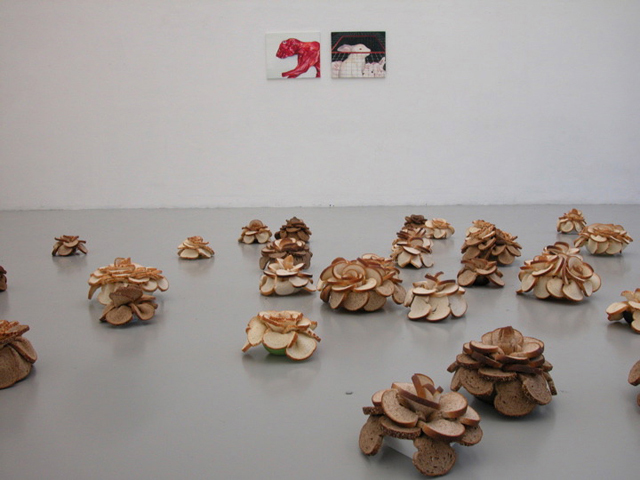







Sudsiri Pui-Ock stayed at the JCVA during March, 2007. Three of her video works (see selected works) were shown at Barbur gallery in Jerusalem in a one-woman show. Although Solitary Consciousness was created in 2004, Pui Ock had never exhibited it before. She said she had waited for a special place to show it, and found it here. The works were uniquely presented in the small gallery space. Solitary Consciousness was projected onto a large, white rectangle painted on the gallery floor. The Tatami Room video was displayed like a picture hung on the wall (on a flat LCD screen). Across the room, the Street of Two Birds played unobtrusively on a small monitor placed on a shelf in the gallery's kitchen.
Pui-Ock gave well-received talks both at the Barbur gallery and at the Bezalel Academy of Art and Design. She made warm, personal connections with many of the people she met, setting the scene for a long-lasting dialogue.| Solitary Consciousness |
This piece summons up the serene nature of water in varied states, including the effects of water on water and wind on water, as well as rain, hail, snow and cloud. The water is ever changing, while the body in this piece is stable in form, supplementing the calming effect of the waves with its own perpetual rolling motion. The juxtaposition of (artist's) body and water suggests a visual metaphor for consciousness with its many moods and qualities. But the calm of nature, further evoked by bird calls, is interrupted by industrial civilization, as represented by the harsher sounds of cars passing nearby. |
| The Tatami Room |
The Tatami room offers an intimate, close-up – or rather, close down – aspect of what is usually seen with a long view: rice fields. Pui-Ock places the camera at a fixed angle, allowing the field to overflow the composition and conquer space so that no horizon or sky is visible. Her gaze enters and embraces the rice stalks as if they carpet her own private room, which is what a tatami room always is. The monochromatic effect enhances her will to blend into the landscape; her body dissolves and then re-appears, seeming insubstantial. She approaches the rice fields with almost religious reverence, and transforms what we usually experience as an open-ended vista into a sacred enclosure. In her own words:" I entered the room. I walked around. Tried to find a way to blend into the landscape. I sat down. I bowed. Can I become a stone in this field?" She thus created a room of her own in nature by visually and artistically re-framing a particular fragment of it. This piece, made in Moriya, Japan, during Pui-Ock's residency there, represents the unspoiled state of the small town before it was overrun by industry and progress. Here the natural background is fixed, whereas the human figure is moving and trying to locate the posture and place which would most fully allow it to merge with its surroundings. This attempt can also be seen as a physical enactment of the artist's larger quest to portray an empathic unity between humans and the natural world. |
| The Street of Two Birds |
|
The piece germinated from the tragic story of an elderly local couple in the community, with a wife suffering from Alzheimer's. Soon after her arrival in Moriya, Pui-Ock heard how the couple, who were in the habit of going out daily for a short drive, were struck by a car that killed the husband and left his wife helpless. "To pay homage to the couple I'd never met, I made rubbings of the image of a family of birds – an ancient, local family's emblem -- from a metal drain cover on the street." Pui-Ock's homage to the couple was completed by changing the street's name from the cold, bureaucratic "street no. 55," to the romantic name commemorating the couple: "The Street of Two Birds." |